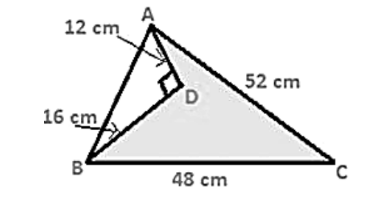Find the area of the shaded region in fig. below

Area of the shaded region = Area of ΔABC − Area of ΔADB
Now in triangle ADB
$\mathrm{AB}^{2}=\mathrm{AD}^{2}+\mathrm{BD}^{2} \ldots .$ (i)
Given, AD = 12 cm, BD =16 cm
Substituting the value of AD and BD in eq (i), we get
$A B^{2}=12^{2}+16^{2}$
$=400 \mathrm{~cm}^{2}$
AB = 20 cm
Now, area of a triangle = 1/2 × AD × BD
$=96 \mathrm{~cm}^{2}$
Now in triangle ABC,
S =1/2 × (AB + BC + CA)
= 1/2 × (52 + 48 + 20)
= 60 cm
By using Heron's Formula
The area of a triangle $=\sqrt{s \times(s-a) \times(s-b) \times(s-c)}$
$=\sqrt{60 \times(60-20) \times(60-48) \times(60-52)}$
$=480 \mathrm{~cm}^{2}$
Thus, the area of a triangle is $480 \mathrm{~cm}^{2}$
Area of shaded region = Area of triangle ABC - Area of triangle ADB
$=(480-96) \mathrm{cm}^{2}$
$=384 \mathrm{~cm}^{2}$
Area of shaded region $=384 \mathrm{~cm}^{2}$
